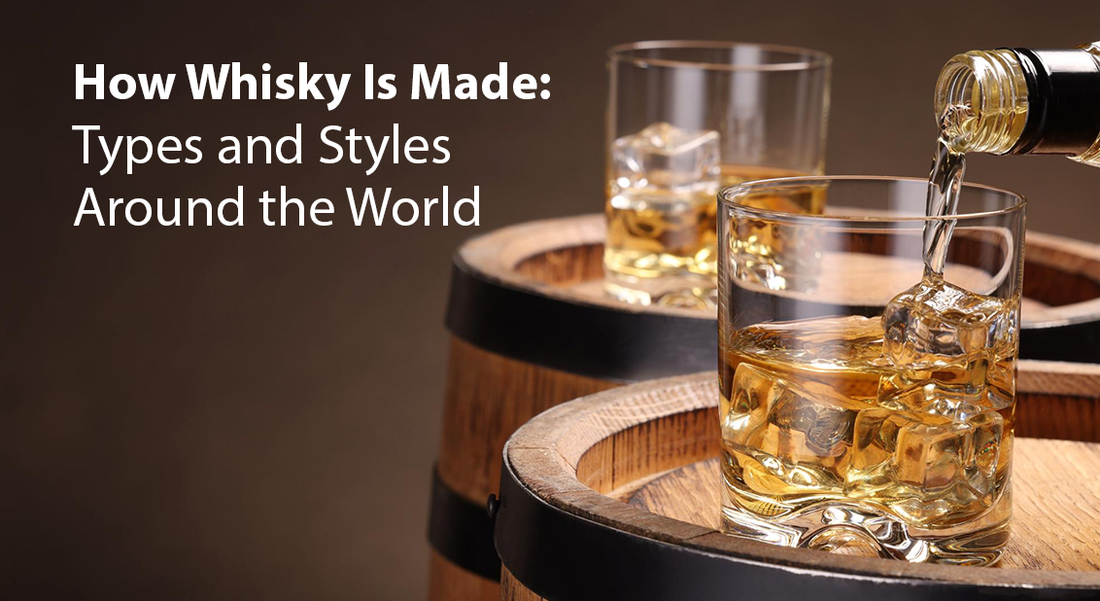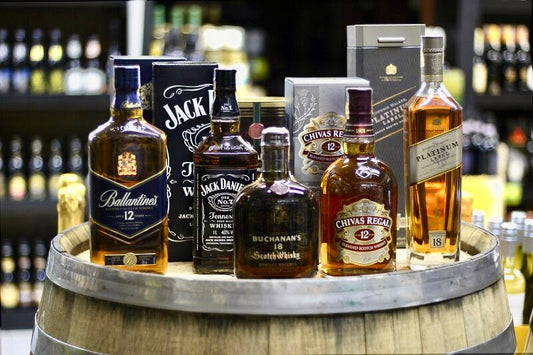
How Whisky Is Made: Types and Styles Around the World
Whisky is often known as “liquid gold”and is one of the world’s most celebrated spirits. With a rich cultural heritage across various parts of the country, from the Speyside region of Scotland to the rolling hills of Adelaide Hills of South Australia, the whisky world is evolving, and every region is thriving in the spirits industry, making it more than just an alcoholic beverage and turning it into an art form.
If you’re new to the whisky world or a passionate lover,this guide will answer all your questions on how whisky is made and what the types and styles from around the world make each bottle unique and exceptional. Here you will find out the fascinating journey of whiskey from grain to glass, diving deep into regional varieties, production methods, and the best qualities that make each style different and your favourite. Thanks to online alcohol delivery, exploring new whisky styles has never been easier.
What is Whisky?
A distilled alcoholic beverage, whisky is manufactured from fermented grain mash, such as barley, corn, rye, and wheat. To give the alcohol its gold-like colour, flavour, and character, the grains are mashed, fermented, distilled, and then aged in wooden barrels, usually oak. The whisky's creation of rich flavours, from vanilla and caramel to smoke and spice, is mostly due to the maturing process. Different regions have specific rules and regulations that include unique production methods, grain composition, and ageing rules, resulting in different taste profiles of each unique type. The spelling with the “e” varies by region: "whisky" in Scotland, Australia, and Japan, while "whiskey" is used in Ireland and the United States. For a refined experience, buy whisky online with Liquor Loot and enjoy expertly curated drams from around the world straight to your doorstep.
How is Whisky Made?
1. Malting
Barley grains are first soaked in water to start the method of germination process. Enzymes that transform starches into fermentable sugars are created during germination. After that, the grains are dried in a kiln to prevent germination. Peat smoke is added during the drying process to peated whiskies, giving the malt unique smoky flavours.
2. Mashing
Then the second step, in a big container known as a mash tun, the malted barley is pounded into a coarse flour known as "grist" and combined with hot water. Enzymes are activated during this process, turning the leftover starches into sugars and producing a sweet liquid known as "wort." For the best sugar extraction, the temperature and duration are meticulously regulated.
3. Fermentation
After cooling, the wort is moved to washbacks, which are fermentation pots, where yeast is added. Over the course of 48–96 hours, the yeast breaks down carbs and creates carbon dioxide and alcohol. As a result, a beer-like liquid known as "wash" with an alcohol level of roughly 7–10% is produced. These substances are also produced during fermentation and add to the final taste profile of the whisky.
4. Distillation
To separate alcohol from water and other substances, the wash is heated in column stills or copper pot stills. Usually, the liquor undergoes two distillations, though Irish whisky occasionally undergoes three. The "heads" (first runoff), the "heart" (middle cut with desirable flavours), and the "tails" (last runoff) are the three components of the distillation process. For ageing, just the heart is gathered.
5. Ageing/Maturation
The "new make," or clear spirit, is kept in oak barrels to mature. The whisky and oak interact during maturation, allowing the whisky to take in aromas like spice, vanilla, and caramel while also mellowing strong flavours. The finished taste is greatly influenced by circumstances such as barrel type, temperature, and humidity. Region-specific legal minimum ageing times vary; for example, Scotch whisky usually requires three years, while some American whiskies have no minimum.
6. Filtration & Bottling
After maturing, whiskies can be bottled as single-barrel expressions or mixed with other barrels to attain stability. Although cask-strength versions stay undiluted, water is frequently added to achieve the appropriate alcohol concentration, which is normally 40–46% ABV. After being filtered, sometimes chill-filtered to avoid cloudiness, the whisky is now ready and is to be packaged for retail.
Whiskey Types by Region
1. Scotch Whisky
-
Origin: Scotland, with the top five regions (Highlands, Lowlands, Speyside, Islay, Campbeltown)
-
Production: Must be made from malted barley, distilled at Scottish distilleries, and aged minimum of 3 years in oak casks
-
Flavour Profile: Highly diverse, Islay offers bold, smoky, peaty notes; Speyside delivers smooth, fruity, honeyed flavours; Highlands range from floral to robust
-
Popular Styles: Single malt (one distillery, 100% malted barley), blended Scotch (mix of malt and grain whiskies)
2. American Whiskey
-
Bourbon: Minimum 51% corn mash, aged in new charred oak barrels; sweet with notes of caramel, vanilla, and oak; primarily from Kentucky
-
Rye Whiskey: Minimum 51% rye grain; spicy, peppery, and dry with fruit undertones; popular in cocktails
-
Tennessee Whiskey: Similar to bourbon but filtered through sugar maple charcoal (Lincoln County Process) before ageing; smooth and mellow
-
Flavour Profile: Generally bold, sweet, and full-bodied with subtle oak and wood influence
-
Notable Characteristics: No minimum ageing for bourbon (except "straight" bourbon requires 2 years); a range of mash bills creates varied expressions
3. Irish Whiskey
-
Production: Typically triple-distilled for exceptional smoothness; can use both malted and unmalted barley
-
Ageing: Minimum 3 years in wooden casks on the island of Ireland
-
Flavour Profile: Light, smooth, and approachable with notes of vanilla, honey, light fruit, and mild spice
-
Popular Styles: Single pot still (mixed malted/unmalted barley), single malt, grain, and blended
-
Notable Characteristics: Known as the smoothest whiskey style due to triple distillation; historically used unmalted barley
4. Japanese Whisky
-
Inspiration: Recreated after Scotch whisky traditions but with Japanese precision and philosophy
-
Production: Uses copper pot stills, various yeast strains, and diverse cask types (Mizunara oak, sherry, bourbon)
-
Flavour Profile: Delicate, balanced, and refined with floral, fruity notes and subtle complexity
-
Notable Characteristics: The focus is on balance and harmony; unique production styles are created by the distilleries' limited blending. Diverse climates, fresh water supplies, and superb craftsmanship.
5. Australian Whisky
-
Emergence: An emerging industry experiencing rapid growth and international recognition
-
Production: Premium single malts using local barley and pure water sources
-
Flavour Profile: Rich, full-flavoured, and innovative with influences from wine cask maturation
-
Characteristics: Warm climate promotes exceptional ageing; experiments with various cask finishes
-
Notable Characteristics: Tasmania is the whisky-producing heartland with a cool climate ideal for maturation
6. Canadian Whisky
-
Production: Typically blended from multiple grain whiskies; often includes rye for spice
-
Ageing: Minimum 3 years in wooden barrels; often aged longer for premium expressions
-
Flavour Profile: Light, smooth, and easy-drinking with mild sweetness and gentle spice
-
Notable Characteristics: Despite its varying grain content, it has historically been referred to as "rye" due to the versatile production restrictions that allow for innovative blending.
Whiskey Production Styles
1. Single Malt Whiskey – Produced at one distillery using 100% malted barley; highlights the distillery's unique character with rich, complex flavours.
2. Blended Whiskey – Uses multiple malt and grain whiskies for consistency and balance; smooth, approachable, and really popular.
3. Bourbon – American whiskey with a minimum of 51% corn; aged in new charred oak; sweet with caramel, vanilla, and oak notes.
4. Rye Whiskey – Minimum 51% rye grain; spicy, dry, and peppery; a great mixer in classic cocktails like Manhattans.
5. Grain Whiskey – Made from corn, wheat, or unmalted grains; lighter and smoother; often used in blends.
6. Tennessee Whiskey – Bourbon-style whiskey filtered through charcoal before ageing; smooth and slightly sweet.
7. Corn Whiskey – At least 80% corn; typically unaged or only mildly aged; fresh and sweet; classic American moonshine.
8. Peated Whisky – Barley dried with peat smoke; distinctive smoky, earthy flavour; iconic in Scottish Islay whiskies.
9. Flavoured/Infused Whiskey – Base whiskey infused with honey, apple, cinnamon, or other flavours; sweeter and more accessible.
FAQs
Q1: What's the difference between whiskey and whisky?
The main and only difference is the language. The spelling with the “e” is mostly used in Ireland and the United States, while other countries and regions use the spelling without “e”, that is, whisky. There’s no difference within the quality or the style of the spirit; it’s just the regional perspective.
Q2: How long does whiskey need to be aged?
Depending on the type and region where it’s coming from, the whisky ageing varies. Like Scotch and Irish whiskey require at least 3 years, whereas bourbon has no such minimum requirements. However, most premium whiskeys are aged much longer, that is, around 10-25 years or even more, to develop deeper, more complex flavours.
Q3: What makes bourbon different from other whiskeys?
Bourbon must be made in the United States, aged in brand-new, charred oak barrels, have at least 51% corn in its mash bill, and be distilled to no more than 160 proof. Bourbon's distinctive, rich, sweet flavour with hints of caramel, vanilla, and oak is the outcome of all of this.
Q4: Can whiskey go bad after opening?
If stored properly, unopened whisky can last for a very long time. Whisky doesn't spoil like wine does, although it does gradually lose flavour and strength due to oxidation after it's opened. If kept upright and out of direct sunlight in a cold, dark place, an opened bottle will usually keep its quality for one to two years.
Q5: What does "single malt" mean?
A single distillery produces single malt whisky using just malted barley. Whisky from several barrels inside one distillery may be included, but they must all come from the same place. This is not the same as "blended," which blends whiskies from several distilleries, or "single barrel," which comes from a single barrel.
This iconic alcoholic spirit is not just a drink, but it’s a harmonious blend of centuries-old traditions, regional influences, and exceptional craftsmanship. From the meticulous production process involving malting, fermentation, distillation, and ageing, to the diverse styles shaped by region, climate, and cultural preferences, every bottle tells a unique story. Whether you enjoy Kentucky bourbon's sweet caramel notes, Japanese whisky's delicacy, Irish whiskey's well-balanced flavour, or the smokiness of peated Scotch, the world of whisky is a journey towards an extraordinary escape. Gaining knowledge of the production process and the characteristics that distinguish each regional style of whisky broadens your enjoyment and lets you find new favourites. To celebrate the amazing journey from grain to glass, pour yourself a dram and enjoy the uniqueness in every sip! Cheers













1 comment
Great read! The blog really breaks down how whisky goes from grain to glass and makes all the different styles feel accessible and interesting.